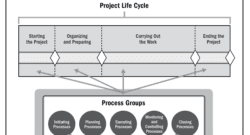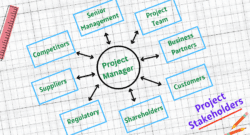Author: Praveen Malik
Praveen Malik, PMP, has two-plus decades of experience as a project management instructor and consultant. He regularly conducts project management workshops in India and abroad and shares his project management thinking in his blog, PM by PM.
What is a Contract and How is it Different from a Project Charter?
Learn about the differences between contracts and project charters, key elements of each document, why they are essential for project success.
Back to Basics: How to Create a Project Charter
Learn how to create a project charter, a crucial document that authorizes a project's existence and outlines its objectives. Discover the key components, best practices, and the importance of obtaining stakeholder buy-in for successful project management.
Back to Basics: What is The Difference Between Product Manager vs Project Manager?
What is the difference between product manager and project manager? Even though they overlap with each other, they are completely different.
Back to Basics: What is Project Governance?
Project governance is an oversight and controlling function that aligns an organizations strategy with the project lifecycle. It provides project managers with a framework for making decisions, defining roles, and ensuring project success. Learn about the key elements of project governance and how it differs from project management
Back to Basics: What is the Difference between Process Groups and Phases?
Many project managers struggle to understand the concept of process groups and often confuse them with project phases. This article explores the differences between the two, explaining how process groups are repeated within each phase of a project and highlighting the importance of distinguishing between them
Back to Basics: Who Are Project Stakeholders and Why Are They Important?
About two decades ago, I was working for an IT Services organization. Our company got a re-engineering project from a Fortune 500 company, and I was designated as the project manager. The client had assigned a “user champion” to walk us through the old system and inform on the requirements. We interacted almost on a daily basis and had a very good working relationship. The project was sponsored by the finance department of the client’s organization. Our milestones, schedule, and timelines were approved by the project sponsor. In essence, we answered to the finance department. From a technology perspective, the project was overseen by the client’s IT department. They were responsible for approving our technical design documents and making major technology decisions. The client had assigned an IT manager to help us with handling our technical queries and with integrating our solution with their software. There were some underlying political currents between finance and IT, and since the project was sponsored by the finance department, the IT department did not want to take any ownership of the project. In fact, the assigned IT manager was not supportive in the beginning at all. This caused initial delays, which did not reflect well on our performance. Luckily, we realized that this was happening and took preventive measures to overcome the situation. The IT department was housed in a location about 50 miles away from our base location, but we made it a point to work from there once a week in order to improve our working relationship with the IT manager. We closely interacted with him and tried to understand his point of view. We would pick his brain about the technology stack and ask for his guidance for every technology decision, no matter how small. The project benefited from our regular interactions with the IT manager and the help he offered. By the end of the project, we became good comrades, and the project was completed successfully. In this short story, I told you about the three stakeholders: the sponsor, the user champion, and the IT manager. I also introduced you to a fourth stakeholder—the project manager. A project manager (PM) has a very important role in maintaining the relationships within a project. In my story, you’ll notice how we managed to convert the IT manager from a negative (resistant) stakeholder to a positive (supportive) stakeholder. Let’s discuss stakeholders in further detail. I’ll be covering who they are and why they are important. Who are Project Stakeholders? A project is not a single person’s effort. It is not even a single team’s effort. It requires a collective and collaborative effort from many other people and groups. The PM is in the center, and must regularly interact, collaborate, and work with the involved people and groups. Collectively, these people are called project stakeholders. As per the PMBOK Guide, a project stakeholder is an individual, group, or organization that may affect, be affected by, or perceive itself to be affected by a decision, activity, or outcome of a project, program, or portfolio. The project manager’s role is to keep the stakeholders involved and informed throughout the project. It’s essential to get stakeholder buy-in, hold them together, and meet their expectations. This is not an easy task. In fact, it’s sometimes the most difficult task of a project. This is due to different stakeholders having different perspectives, interests, and opinions. Types of Stakeholders Internal vs. External Internal Stakeholders are people working within a project manager’s organization. Examples include: The project sponsor: a person or group providing resources and support for the project, who is accountable for enabling success. Functional Groups: departments or groups that are either influenced by decisions of the project team or are involved in completing the project. Some examples include human resources, marketing, sales, legal, finance, operations, manufacturing, etc. External Stakeholders are people working outside the project manager’s organization. Examples include: Customers: individuals who approve and oversee the project’s service, product, or outcome. Vendors: businesses that supply services or other resources required to complete some of the project work. End users: people or groups who will eventually use the product created by the project. The project sponsor is different from customer. The sponsor provides funds and resources for the project, whereas the customer (or client) gives requirements. Negative vs. Positive A negative stakeholder is one whose interests are not aligned with the project objective. They believe that they will be negatively impacted by the outcome of the project. They are also referred to as resistant stakeholders. A positive stakeholder seeks benefits from a project’s success. They believe that they will be positively impacted by the outcome of the project. They are also called supportive stakeholders. Why are Stakeholders Important? Projects are governed, managed, and executed by project stakeholders. Projects wouldn’t exist without them. They provide requirements, share knowledge, oversee a project, and contribute resources, as well as do many other things that are essential for completing a project. They are instrumental for a project’s success. It is essential for project managers, to effectively communicate with the stakeholders and manage their expectations. Project managers should seek their feedback and ensure that they’re satisfied with the results. The project stakeholders (not including the PM or the project team) are responsible for all of the following project tasks: Give authorization to start the project. Provide necessary resources to the project. Decide project budget and assist with securing project funding. Provide project requirements. Help with planning. Give approvals to Project Team. Identify project risks. Oversee the project. This is not an exhaustive list of tasks. A good PM will try to involve stakeholders in as many ways as possible. Conclusion Stakeholders are the people or groups of people who are involved, interested, or impacted by the project. They could be internal or external, negative or positive, and/or low in power or high in power. Identifying stakeholders is a continuous process that runs throughout the entire project timeline. The number of stakeholders can grow as a project progresses. New stakeholders can be identified, and the role of stakeholders can change with time. Recognizing a stakeholder, understanding their degree of influence on a project, and addressing their needs, demands, and expectations is vital to every project’s success. As a project manager, you should be aware of interests, expectations, and idiosyncrasies of your project’s stakeholders. You should seek their help by engaging with them and involving them in project activities. If you play your cards well, stakeholders will help you in completing your project successfully. On the other hand, if you fail to handle stakeholders appropriately, your project could be jeopardized. How do you recognize the importance and influence of a stakeholder? How do you involve influential stakeholders in your project? I would love to hear from you in the comments section below.
Back to Basics: Assumptions vs. Constraints vs. Dependencies
I regularly provide project management advisory and Project Management Office (PMO) related consulting services to my clients. On many occasions, I have found that project managers do not distinguish between assumptions, constraints, and dependencies properly. Many do not think it is essential; however, I don’t think that project managers are necessarily at fault for this. I believe it is something to do with environmental and/or organizational culture. In many organizations, the terms, assumptions, constraints, and dependencies, are used interchangeably. As such, these terms are thought of as special project management terms having the same or similar meanings, which is simply not true. Here are the English language meanings of these terms from Merriam Webster’s online dictionary: Now let’s consider the broader meaning of these terms by looking at their importance in the project management context. Example Statements Before we fully explore these three terms, let’s consider some example statements. The following are related to two tasks in a project—Requirements Approval and Design System: Can you determine which of these statements is an assumption, which is a constraint, and which is a dependency? I will share the answers and explanations at the end of this article. What is an Assumption in Project Management? Assumptions are events or conditions that are that are believed to be true. They are stated without any proof or evidence. A project manager must make certain assumptions in order to proceed with any project as there are always factors beyond one’s control. Assumptions are not supported by facts. They are based on the knowledge and experience of the stakeholders, as well as the information available for a project. They have to be documented and managed throughout the project. Assumptions are essential for planning a project. A perfect plan can be made only if you have complete information about a project, but that is seldom the case. There are always some gaps, which can be filled only by making assumptions. If you wait too long for all the information to be available, the project will be delayed indefinitely. It is important to note that since assumptions are not certain and they may or may not come true, they are considered potential risks. What is a Constraint in Project Management? Although assumptions are inevitable to some degree, it’s never fair to assume that a project has unlimited resources and/or and unlimited budget. Every project has limited resources and limited money. Generally, a specific number of resources are assigned, and a budget is allocated to a project. The project manager must complete the project using assigned resources and within the available budget. Project constraints are defined as anything that limits or dictates the actions and decisions of a project team. Constraints restrict the options a team has. The PMBOK Guide lists six project management constraints. They are as follows: You can read my article on project constraints to understand the above list in further detail. In addition to these, the project team might face constraints related to many other things, such as competitors, environment, technology, and government regulations. What is a Dependency in Project Management? Unlike assumptions and constraints, dependencies (usually schedule dependencies) exist between two activities. A dependency can be represented as a directional relationship. The two activities are called the predecessor and the successor. They are separated by an arrow in the below figure, which signifies the direction of the dependency. The above project schedule network diagram depicts a finish-to-start relationship, one of the four relationships possible between two activities. Finish-to-start relationships are the most common. In this relationship, the start of the successor activity depends on the finish of the predecessor activity. Your project could have dependencies on the activities that are external, such as activities that your client or vendor is responsible for. It is essential to consider all activities in a project, whether they are internal or external. Differences The key differences between these terms is that assumptions are stated without proof or evidence, constraints are limiting factors, and dependencies signify a relationship between two activities. By now, you can probably correctly associate the three example statements (from the beginning of the article) as an assumption, constraint, and dependency. Over to you High-level assumptions, constraints, and dependencies should be identified and documented at the start of a project. They are refined and detailed as more information becomes available and the project progresses. They should be analyzed and managed throughout the project lifecycle. I would love to hear from you. How do you use these terms in your organization? How do you document assumptions, constraints, and dependencies in your project?
Why is Project Management Important?
I have been conducting PMP training workshops for about 15 years. I usually start my training sessions by asking participants to introduce themselves and state their expectations of the training program. This typically results in about 15-20% of students saying that their expectation is to learn project management. I usually have to explain that although the PMP exam is based on project management, the primary focus of PMP training workshops is to help participants to crack the PMP exam—not necessarily learn project management. Sitting for the PMP exam will give one an understanding of the various project management processes, tools, and techniques, but there’s not much covered which applies these theories and methodologies to real life projects. Furthermore, you won’t learn about best project management practices. If you are just testing the waters, look at my recent back to basics article series. These topics will upgrade your knowledge about the fundamentals of project management. If you want to really learn project management and understand its nuances; however, MPUG membership is the way to go! Sign up for MPUG’s annual membership (going on Sale in September!), which will allow you access to some of the best extensive training material and learning videos. That said, I have written this article specifically to address two key questions. Let’s explore what project management is and why it is important. What is Project Management? What a loaded question! Here are a few definitions of project management: The art and science of managing a project from initiation to closing, in order to deliver a successful product or start a service. An approach used to manage work within constraints of time, cost, quality, resources, and risk to meet agreed upon performance targets. The combination of systems, techniques, and people required to complete a project within established goals of time, budget, and quality. In my opinion, the best definition of project management comes from the PMBOK Guide: Project management is the application of knowledge, skills, tools, and techniques to project activities to meet project requirements. As per the definition, project management is the “application of knowledge, skill, tools, and techniques….to meet project requirements.” There are two important keywords here “application of…” and “project requirements.” In my interpretation, project management basically means that project managers have to use their expertise to meet the project requirements, and that leads us to another question. What kind of expertise does a project manager need and what are project requirements? Areas of Expertise Much of the knowledge and many of the tools and techniques for managing projects are unique to project management, such as critical path analysis and earned value management. However, only the application of knowledge and skills related to project management processes is not enough to manage projects effectively. Project managers need to understand and use their knowledge and skills from at least five areas of expertise to effectively manage projects. These areas are: Project management: this knowledge area describes what is unique to the field of project management. It includes knowledge about the five process groups, and ten knowledge areas, and overlaps with four management disciplines (keep reading). Application expertise: Many projects are similar to each other because of the same domain or application area (i.e., construction projects and software projects). Such projects have common elements of knowledge significant for such, but of which may not be required for other types of projects. Understanding of the project environment: Almost all projects are initiated, planned, and implemented in a specific economic, social, and environmental context. This has intended and unintended positive and/or negative impacts. The project team should be aware of and consider the impact of social, cultural international, political, and physical environmental contexts. General management: This area includes knowledge and skills related to staffing, organizing, financial management, accounting, procurement, sales and marketing, logistics, supply chain, and information technology. Interpersonal skills: This area is related to effective communication, influencing, leadership, negotiation, conflict management, motivating team members, and problem-solving. Project Requirements Requirements are a group of tasks or conditions that must be completed to finish the project successfully. They are documented after understanding the needs and expectations of various stakeholders. A project stakeholder is an individual, group, or organization who participates in project activities or is interested in the outcome or may affect or be affected by the outcome of a project. Project requirements could be related to all of the following: Business issues and opportunities Product features Quality, testing, and validation Transition and handover Warranty and support To paraphrase the definition of project management, we can say that project management is the application of five types of knowledge and skills in order to accomplish the requirements and satisfy the stakeholders. Managing a project includes, but is not limited to, all of the following activities: Identifying requirements Establishing clear and achievable objectives Balancing the competing demands for quality, scope, time and cost. Initiating, planning, executing, monitoring & controlling, and closing the project. Satisfying the concerns and expectations of the different stakeholders. You can look at my article on role of a project manager to checkout a comprehensive list of activities that are done while managing projects. Why is Project Management Important? Irrespective of the nature, size, or complexity of a project, all projects need careful planning, organization, implementation, and monitoring. Without such, projects can either fail or become challenged. In order to deliver successful projects, one needs to implement various project management processes and follow best practices. Here is a list of top benefits of implementing best practices of project management: Strategic alignment with organizational goals Consistent and speedy decisions Improvement in customer satisfaction Realistic estimation and planning Effective resource allocation Higher productivity and improved resource utilization Increase in employee motivation and morale Improved quality of end product Saves time for implementation Reduces overall cost Facilitates proactive risk management Conclusion Every project is unique and inherently risky. Without proper project management, things can become chaotic. A successful implementation of a project management processes can bring about structure and order. By following the best practices of project management, you can get clarity on objectives, improve an implementation plan, reduce risk, and deliver a quality product on time and within budget. You can improve overall customer satisfaction, motivate team members, and make stakeholders happy. I want to know that you think: which of the above definitions best describes project management? A number of people believe that project management is nothing more than common sense. Do you subscribe to their views? Do you think that project management is important? What are some of the other benefits that can accrue by following the best practices of project management? Leave me a comment below!










